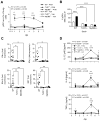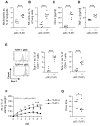Plasmacytoid dendritic cells promote host defense against acute pneumovirus infection via the TLR7-MyD88-dependent signaling pathway
- PMID: 21482736
- PMCID: PMC3404606
- DOI: 10.4049/jimmunol.1002635
Plasmacytoid dendritic cells promote host defense against acute pneumovirus infection via the TLR7-MyD88-dependent signaling pathway
Abstract
Human respiratory syncytial virus (RSV) is the leading cause of lower respiratory tract infection in infants. In human infants, plasmacytoid dendritic cells (pDC) are recruited to the nasal compartment during infection and initiate host defense through the secretion of type I IFN, IL-12, and IL-6. However, RSV-infected pDC are refractory to TLR7-mediated activation. In this study, we used the rodent-specific pathogen, pneumonia virus of mice (PVM), to determine the contribution of pDC and TLR7 signaling to the development of the innate inflammatory and early adaptive immune response. In wild-type, but not TLR7- or MyD88-deficient mice, PVM inoculation led to a marked infiltration of pDC and increased expression of type I, II, and III IFNs. The delayed induction of IFNs in the absence of TLR7 or MyD88 was associated with a diminished innate inflammatory response and augmented virus recovery from lung tissue. In the absence of TLR7, PVM-specific CD8(+) T cell cytokine production was abrogated. The adoptive transfer of TLR7-sufficient, but not TLR7-deficient pDC to TLR7 gene-deleted mice recapitulated the antiviral responses observed in wild-type mice and promoted virus clearance. In summary, TLR7-mediated signaling by pDC is required for appropriate innate responses to acute pneumovirus infection. It is conceivable that as-yet-unidentified defects in the TLR7 signaling pathway may be associated with elevated levels of RSV-associated morbidity and mortality among otherwise healthy human infants.
Figures








References
-
- Glezen P, Denny FW. Epidemiology of acute lower respiratory disease in children. N Engl J Med. 1973;288:498–505. - PubMed
-
- Hall CB. Respiratory syncytial virus and parainfluenza virus. N Engl J Med. 2001;344:1917–1928. - PubMed
-
- Trinchieri G. Interleukin-12 and the regulation of innate resistance and adaptive immunity. Nat Rev Immunol. 2003;3:133–146. - PubMed
-
- Akira S, Uematsu S, Takeuchi O. Pathogen recognition and innate immunity. Cell. 2006;124:783–801. - PubMed
Publication types
MeSH terms
Substances
Grants and funding
LinkOut - more resources
Full Text Sources
Molecular Biology Databases
Research Materials

